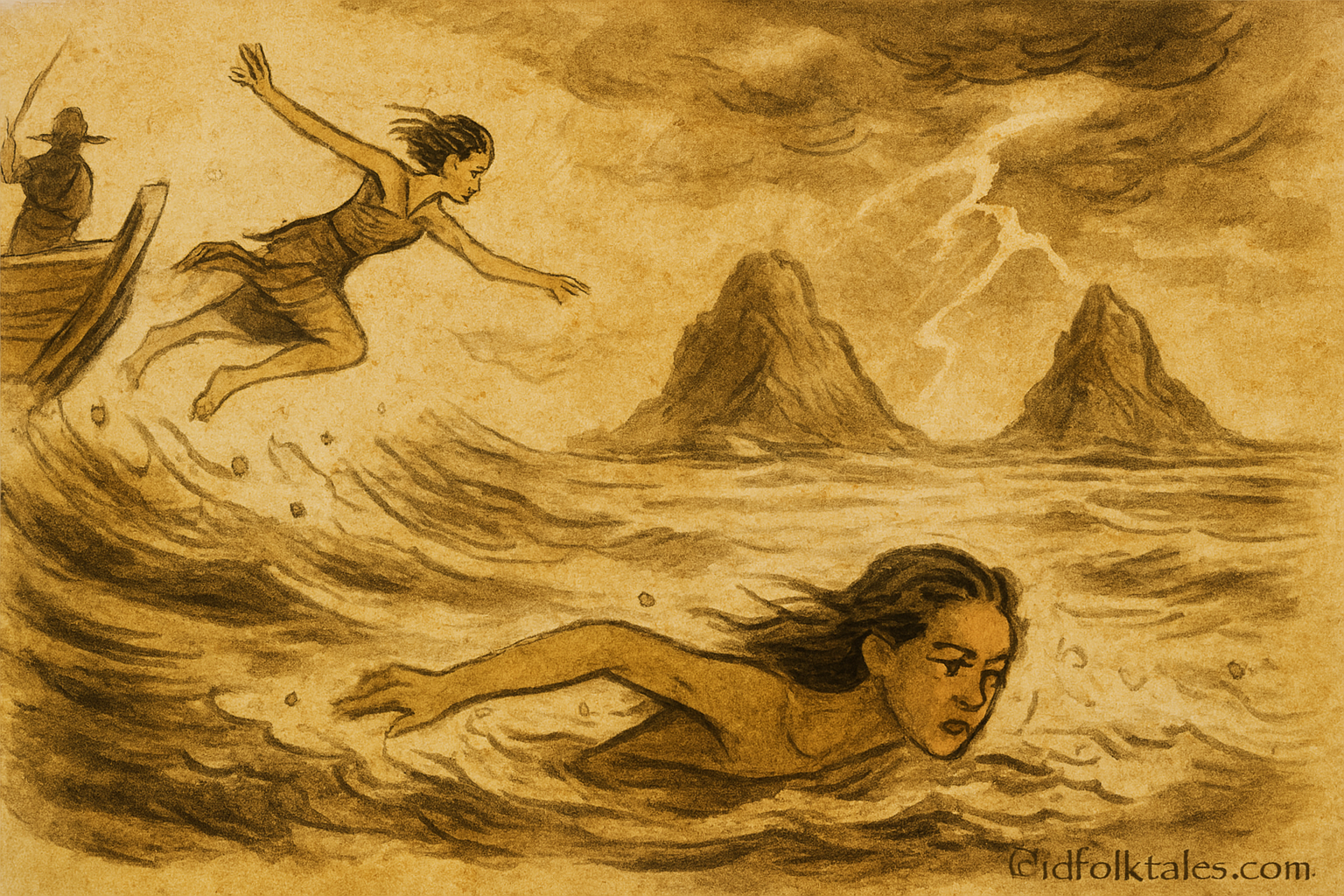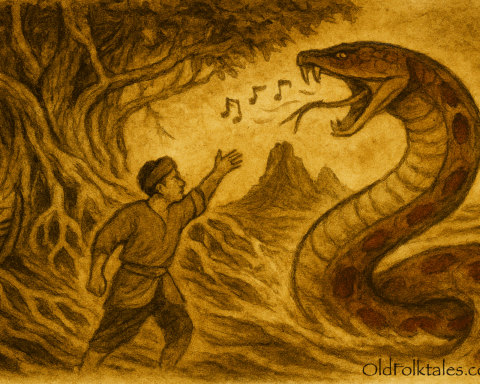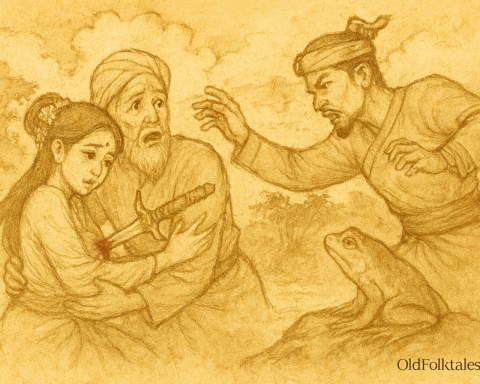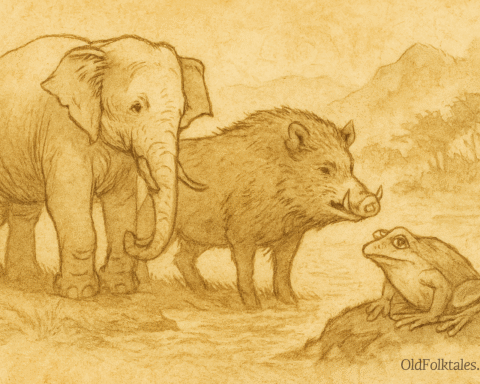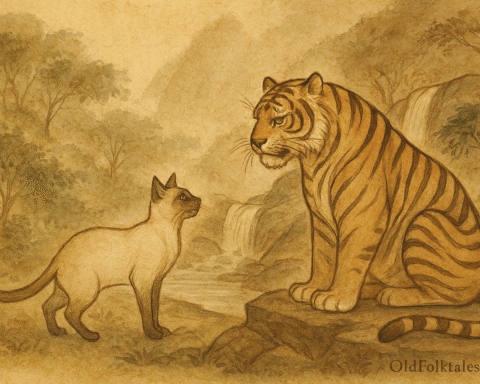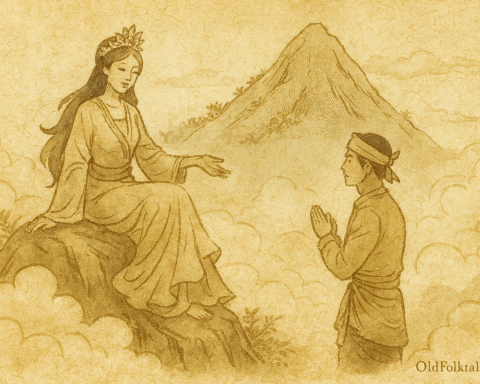In a small coastal village on the shores of what would one day become Singapore, there lived a poor widow who had been blessed with two daughters as beautiful as they were devoted to one another. Minah, the elder, had eyes that sparkled like the morning sun on water, and Linah, the younger, possessed a smile that could warm the coldest heart. Though their family had little in the way of material wealth, their home was a simple wooden hut with a thatched roof, and their meals often consisted of nothing more than rice and dried fish the three women were rich in the love they shared.
The sisters were inseparable. From the time they could walk, they had done everything together collecting shells along the beach, helping their mother mend fishing nets, drawing water from the village well. They shared dreams and secrets, joys and sorrows, and as they grew into young women of remarkable beauty, they made a sacred vow to one another: they would marry two brothers, so that even in marriage, they would never have to be parted. They would live side by side, raise their children together, and grow old in each other’s company.
When word of the sisters’ beauty and their unusual vow spread throughout the village and beyond, suitors began to arrive. Young men from neighboring villages came bearing gifts of fruit and flowers, hoping to win the heart of one or both sisters. But none came in pairs of brothers, and so the sisters politely declined every proposal, remaining faithful to their promise to each other. Their mother, though she worried about their future, understood the depth of their bond and did not force them to separate.
A year passed in this way, with the sisters continuing their simple life by the sea. Then tragedy struck their mother fell ill with a fever that would not break. Despite their desperate prayers and the herbs prepared by the village healer, the widow grew weaker each day. On a night when the moon hung low and full over the water, she passed away, leaving her daughters alone in the world.
With no means to support themselves and no close relatives in the village, Minah and Linah had no choice but to leave the only home they had ever known. They traveled to a distant village where their mother’s brother lived an uncle they barely remembered from childhood visits. He was not a cruel man, but neither was he particularly warm. He took them in out of duty rather than affection, giving them a small corner of his home and assigning them chores to earn their keep.
The sisters adapted to their new life as best they could. Each morning, Linah would walk down to the well near the sea to fetch water for the household. It was a pleasant enough task on clear days, when the ocean breeze cooled her face and seabirds wheeled overhead, their cries echoing across the waves.
One fateful morning, as Linah lowered her bucket into the well’s cool depths, she heard rough voices and coarse laughter. Looking up, she found herself surrounded by a group of men unlike any she had seen before. Their clothes were salt-stained and tattered, their faces weathered and scarred, and at their belts hung curved knives that caught the sunlight with menacing gleams. Pirates.
The pirate chief, a tall man with a jagged scar running down his left cheek and eyes as hard as coral stone, stopped in his tracks when he saw Linah. Her beauty struck him like a physical blow. Here, he thought, was the most exquisite creature he had ever seen. Without hesitation, without consideration for her feelings or circumstances, he strode toward her with the confidence of a man accustomed to taking whatever he desired.
Linah’s heart pounded with terror. She dropped her bucket and ran, her feet flying over the sandy path as she raced toward her uncle’s house. Behind her, she could hear heavy footsteps and the pirate chief’s shouts. She burst through the door of her uncle’s home, gasping for breath, with the pirate chief close behind.
The uncle and his family cowered in fear as the pirate chief brandished a wicked-looking dagger, its blade gleaming in the dim light of the house. His demand was simple and absolute: he would marry Linah. There would be no discussion, no negotiation. She would be his bride, willing or not.
That night, while the pirate chief and his men camped on the beach below, the two sisters held each other and wept. Their tears soaked the thin mat where they lay, their bodies shaking with grief and terror. They had survived the loss of their mother, adapted to a new home, endured poverty and hardship—but this was a cruelty beyond bearing. To be torn apart after vowing to remain together forever was a fate worse than death itself.
“I cannot leave you,” Linah sobbed into her sister’s shoulder.
“And I cannot let them take you,” Minah replied, her voice fierce despite her tears. “Whatever happens, we will face it together. We made a vow, little sister. Not even a pirate chief can break what we have sworn.”
When dawn broke over the horizon, painting the sky in shades of pink and gold, the pirate chief returned with sixteen of his men. Their uncle, terrified for his own family’s safety, did nothing to stop them as they entered the house. The pirates found the sisters clinging to each other, their arms wrapped tight as if they could merge into a single being that could never be divided.
But the pirates were strong and ruthless. They pried the sisters apart with rough hands, ignoring their cries and pleas. Minah was shoved violently to the ground, her head striking the wooden floor. Through blurred vision, she watched in horror as the pirate chief hoisted Linah over his shoulders like a sack of rice and strode toward the beach where his boat waited.
Minah struggled to her feet, pain shooting through her body, and ran. She ran as she had never run before, her feet pounding across the sand, her lungs burning with effort. She reached the water’s edge just as the pirates were pushing their boat into the waves. Without hesitation, without thought for her own safety, Minah plunged into the sea.
The water was rougher than it had appeared from shore. Strong currents pulled at her body, and the waves rose higher with each passing moment. But Minah swam with desperate strength, fighting against the ocean itself to reach the boat where her sister was being held captive. She could see Linah struggling against the pirate chief’s iron grip, could hear her sister’s cries carried back on the wind.
A massive wave, larger than any before it, rose up like a wall of water and crashed down on Minah. She was pulled under, dragged down into the churning depths. On the boat, Linah saw her sister disappear beneath the surface. With a cry of anguish that pierced even the howling wind, she broke free from the pirate chief’s grasp and threw herself overboard into the violent sea.
At that very moment, as if the heavens themselves had witnessed this tragedy and responded with fury, a storm erupted. The sky darkened to the color of slate, and lightning split the clouds with brilliant white fire. Thunder crashed like the anger of ancient gods. Rain lashed down in sheets, and the wind howled with a voice that seemed almost human in its grief and rage. The pirate boat was tossed about like a toy, and some say the vessel and all its crew were lost to the depths that day.
The storm raged through the night and into the next day, unprecedented in its violence and duration. When it finally exhausted itself and the sun broke through the dissipating clouds, the villagers emerged from their homes to survey the damage. They gathered at the shore, looking out across the now-calm water.
There, where the sisters had disappeared beneath the waves, stood two islands that had not existed before. They rose from the sea like monuments, rocky and green with vegetation, separated by a narrow but deep channel of water. The villagers understood immediately what they were witnessing the sisters had been transformed, their love for each other and their vow never to be parted made manifest in stone and earth.
From that day forward, the islands were known as Sisters’ Islands. The larger island was called Pulau Subar Laut, Big Sister’s Island, representing Minah who had tried so bravely to save her sister. The smaller island was called Pulau Subar Darat, Little Sister’s Island, for Linah who had chosen death over separation. The narrow channel between them represented the distance that had briefly separated them in life but could not keep them apart in death.
To this day, the Sisters’ Islands stand south of Singapore, two islands that appear separate but are forever connected beneath the waves, just as Minah and Linah had promised each other. Local fishermen and sailors speak of the islands with respect, and many believe the spirits of the sisters still watch over those waters, protecting other siblings and ensuring that true bonds of love can never truly be broken.
Journey through enchanted forests and islands in our Southeast Asian Folktales collection.
The Moral
This legend teaches the profound power of familial love and loyalty. Minah and Linah’s devotion to each other was so deep that they chose death over separation, demonstrating that true bonds transcend physical existence. The story also warns against violence, greed, and the forceful taking of what does not belong to us the pirate chief’s selfish desire brought about not only the sisters’ deaths but his own destruction as well. Most importantly, the legend reminds us that love and loyalty create legacies that endure beyond mortal life. The sisters kept their vow to remain together, and their story continues to inspire us centuries later. In a world that often tries to divide us, the Sisters’ Islands stand as eternal testimony to the unbreakable bonds between those who truly love one another.
Knowledge Check
Q1: Who were Minah and Linah, and what was their sacred vow?
A: Minah and Linah were two sisters, daughters of a poor widow in a coastal village near Singapore. They were so devoted to each other that they made a sacred vow to marry two brothers so they could always live together and never be separated, even in marriage.
Q2: What happened to the sisters after their mother died?
A: After their mother died from illness, the sisters had no means to support themselves. They left their village to live with their mother’s brother (their uncle) in a distant village, where they were given shelter in exchange for doing household chores.
Q3: How did the pirate chief encounter Linah?
A: Linah met the pirate chief while fetching water from a well near the sea, one of her daily tasks. The pirate chief and his men encountered her there, and he was immediately struck by her beauty. When she fled in fear, he pursued her to her uncle’s home and demanded to marry her, brandishing a dagger to enforce his will.
Q4: What did Minah do when the pirates took her sister?
A: When the pirates forcibly separated the sisters and carried Linah to their boat, Minah was pushed to the ground. Despite her injuries, she got up and ran to the water, then swam after the boat trying to rescue her sister. A large wave swept her under, and she drowned in the attempt to save Linah.
Q5: How did Linah die, and what happened to the pirate chief?
A: When Linah saw her sister disappear beneath the waves, she broke free from the pirate chief’s grip and threw herself overboard to join Minah in death rather than be separated. At that moment, a violent storm erupted, and it is believed the pirate boat and all its crew were destroyed by the tempest.
Q6: What are the Sisters’ Islands and what do they represent?
A: The Sisters’ Islands (Pulau Subar Laut and Pulau Subar Darat) are two islands south of Singapore that, according to legend, appeared where the sisters drowned. The larger island represents Minah (Big Sister), and the smaller represents Linah (Little Sister). The narrow channel between them symbolizes how they remain forever connected despite being physically separate fulfilling their vow to never truly be apart.
Source:
Traditional Singaporean legend “Sisters’ Islands” (Pulau Subar Laut and Pulau Subar Darat)
Cultural Origin: Singapore (Malay folklore)
